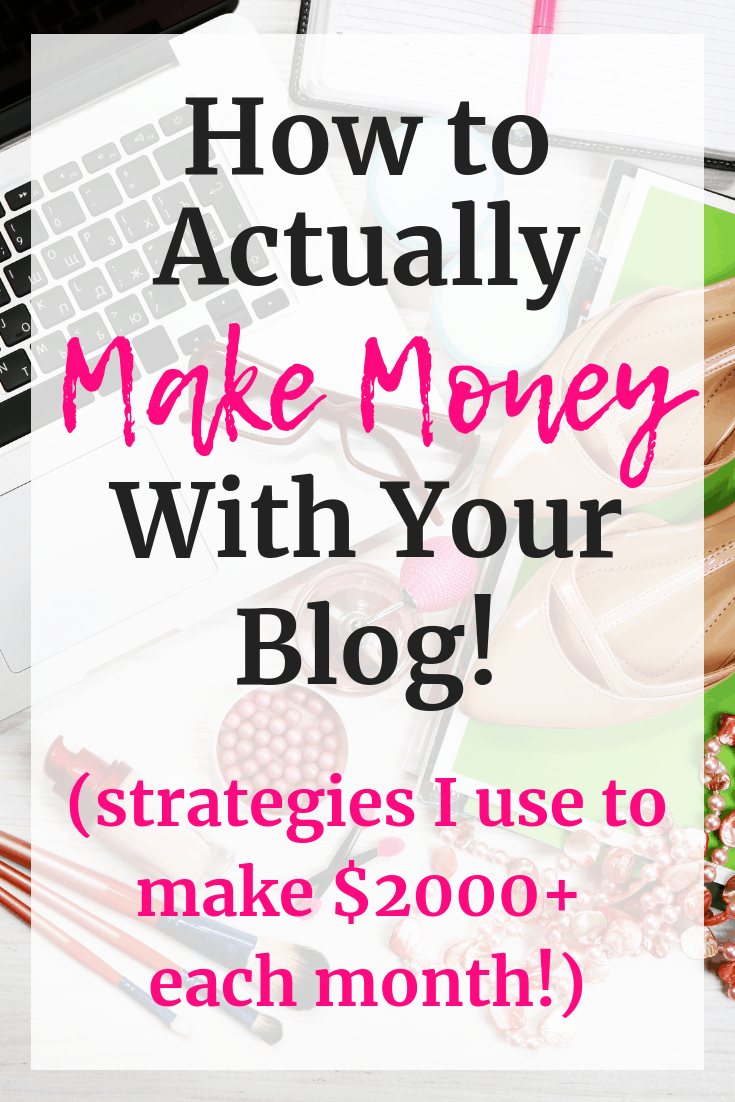
5 Best Ways to Make Money Blogging for Beginners
Have you ever had a conversation with someone and you tell them you’re a blogger? If you’re like me, you may have gotten the follow up question that always seems to follow: “how do you make money blogging?” It’s a valid question for sure – most of us start blogging because we want to share our thoughts and insight, but the ins and outs of monetization can be a little tougher to figure out. This post is designed to help you figure out the best ways to make money blogging for beginners – and how you can implement these strategies on your own site.
5 Best Ways to Make Money Blogging for Beginners
Disclosure: This post may include affiliate links or referral links, where I make a small commission or credit if you purchase via that link. It does not change your user experience.
Whether you just launched your site a few days ago, or you’ve had your blog for a while and are looking to take it from hobby to business, here are 5 key ways to make money blogging.
1. Ad Revenue
Ads are the quintessential form of passive income, right? Once they’re set up on your blog, you’ll be making money while you sleep – or at least that’s how a lot of people portray it. 😉
In reality, making a decent ad revenue requires traffic. And you won’t have traffic without a good arsenal of quality content that you’ve spent time optimizing for Pinterest and SEO.
So yes, you can make money while you sleep with ads – but there’s a lot of upfront work that goes into getting enough traffic to make those ads worth it.
A lot of bloggers start implementing Google Adsense as on their blog early on – which is fine – but you’re probably not going to be making more than spare change each day on that.
How much traffic makes them worth it? I’d say once you hit around 10,000-15,000 page views a month, you can make a little extra money. At that point on one of my sites, I had ads with Monumetric (an ad network) and was pulling in around $40-100 a month.
But the real money comes once you hit 25,000 sessions per month – at that point, you can apply for the ad network Mediavine. This is by far the fan favorite of bloggers (in addition to Ad Thrive, but they require 100,000 page views a month). When you’ve reached that threshold for Mediavine, you’re probably looking at a few hundred dollars a month in their network. This will only continue to grow as your traffic further increases.
The exception to this 25,000 rule is if you have a hyperlocal blog and can possibly sell direct ad space to local businesses, rather than relying on an ad network. In this case, you can monetize via ads with far lower page views.
The takeaway: Focus on the long-term game, using Pinterest and SEO to drive traffic to quality content. Build up those page views to join a good ad network.
2. Affiliate Marketing
Affiliate marketing is a way to make money by helping sell other companies’ products. Essentially, they give you a special link, and if someone purchases their product using your link – you make a commission.
Affiliate marketing is a great option for beginners, because you can make money with a small but engaged audience. As your traffic grows later, those affiliate sales will likely also grow.
How do you get started with affiliate marketing? Try sitting down and making a list of all the products that you use regularly and/or products that you are very brand loyal to. For example, for many wellness bloggers, this might include fitness apparel, sneakers, supplements, essential oils, books about nutrition/fitness, etc.
Then just start googling those brands to see if they have an affiliate program. Most companies run their affiliate programs through affiliate networks – sites that assimilate many different affiliate programs under one roof. Here are a few of the common affiliate networks you can look into joining:
- Share A Sale – Popular merchants include Reebok, Flirty Aprons, Wayfair.com, Sunbasket
- Awin – Popular merchants include Etsy, Bodybuilding.com, Fiverr, Dinnerly
- Rakuten Marketing – Popular merchants include lululemon, Champion
- CJ Affiliate (formerly known as Commission Junction) – Popular merchants include Columbia, Brooks, Road Runner Sports, eMeals
Joining affiliate networks can also give you more ideas for potential companies to promote, as they have a ton of brands in one spot.
In addition to the big brands and affiliate networks, you might be surprised that many online courses and programs also have affiliate programs. For example, Ultimate Bundles does few great healthy living bundles of e-books and online courses that is steeply discounted. Affiliates can market this to their audience to make a 40% commission on each sale.
Think outside the box too. Are you a fitness blogger? Maybe there is a great online personal training platform that you could promote. Or are you a wellness blogger that talks about essential oils? Maybe another blogger has a thorough e-book on them that you could sell as an affiliate, or a company that makes essential oils has their own program. Think creatively and do your research online to find the best options that fit your site.
3. Sponsored Content
Sponsored content is a bit different than affiliate marketing. With affiliate marketing, you only make money if someone purchases a product through your link. But with sponsored content, you are generally paid a flat fee up front for content creation featuring the brand’s product.
Sponsored content can come in many forms:
- Blog posts (with or without social shares)
- Instagram feed posts or stories
- Other sponsored social shares (twitter, facebook, Pinterest)
- Video content – hands-in-pans recipe videos, workout videos, live video, etc.
- Hosting twitter parties
- Brand ambassador (consistent monthly deliverables for an ongoing contract)
For example, if you have a healthy food blog, a company may pay you to use an ingredient in a recipe. Or if you have a fitness blog, a company may pay you to feature their sneakers in an Instagram shot.
There are typically three ways that you can secure sponsored content partnerships:
a) The brand reaches out to you.
This can happen during the beginner phases, and will happen more often as you become a more established blogger. But if you’re just waiting around hoping for brands to come to you, you’re missing out on a ton of opportunities.
Brands have hundreds of thousands of bloggers and influencers to sift through. The odds of them stumbling across your site are relatively small in the grand scheme of things. It can happen, but you’ll have much better luck working with brands if you utilize the next two methods.
Also, keep in mind there are many sketchy people that will often try to take advantage of new bloggers. They may say they want to do a sponsored post on your Instagram feed, but only offer you a discount on their items. This is not normal. At the very minimum, sponsored content should include free product. (But I encourage you to try to secure compensated opportunities, even early on, as long as you have an engaged audience that’s interested in what you’re saying.)
b) You pitch brands.
In this case, you approach the brand and pitch them with a wonderful idea for a partnership. This typically takes more time than option a or c, but I also think it lends itself to being the most successful. Pitching directly gives you more control over the ask/deliverables, pay, and you can usually sell yourself a bit better.
That said, it’s sometimes hard to reach the right person. I have found contacts via social media (a lot of times the person that handles companies social is also involved in their influencer marketing) or press releases.
If you’re nervous about pitching, be sure to read through this post on money making sponsored partnerships which has a ton of tips for pitching. You may also want to put together a media kit in case a brand requests to see one.
c) Use a network to find opportunities
Networks are essentially a third-party website that aggregate opportunities from various brands. You apply for these opportunities through the network and are notified only if you are selected.
The network takes a cut from the brand, so the rates they offer are generally lower than pitching directly. But it’s often a way to get partnerships that you may not have otherwise thought about, and it makes it easy to apply for several opportunities all in one spot.
For example, I just logged into SoFab (one network site) and I see opportunities for a hair color brand, sparkling water, a probiotic, a baby care product, etc.
Some networks may require a minimum number of page views in order to join, and others may be open to everyone. Here are a few networks you may want to check out:
- Social Fabric
- Sway
- Clever
- Influence Central
- TapInfluence
- IZEA
- Activate
- Linqia (unlike other networks, the pay is typically dependent on clicks – though they occasionally have flat rate campaigns).
4. Your Own Products
Think about why you started a blog. Most likely, it was because you had some kind of information that you wanted to share with others. Now think – is there a way that you could really dive deep into that information to develop a paid product out of it?
Paid products might include:
- E-books
- Print books (Amazon CreateSpace make this easy to do!)
- Online course (with video, audio, and/or text-based learning)
- Membership site
- Physical products – t-shirts, skincare line, etc.
Let’s take a look at some examples from a few niches:
- Nutritionist bloggeer – e-book specific to a certain medical condition or diet (i.e. nutrition for PCOS; the keto diet; etc)
- Running blogger – customized or semi-customized training plans
- General wellness blogger – online course on how to use essential oils
- Fitness blogger / personal trainer – membership site with weekly workouts
- Fashion blogger – their own clothing line
- Lifestyle blogger – printable or tangible planner
- Photography blogger – stock photo library for other bloggers
Here’s a personal example: When I realized that a lot of other RDs and wellness bloggers were struggling with SEO, I developed an online course specifically for them that has done fairly well. I try to update it every 6-12 months and then do heavy promotion around the updates.
5. Your Own Services
Blogging and social media opens up a giant online community for you to reach. While you may be trying to focus on passive income, don’t also discount the possibility of service-based income. Especially when you’re getting started, it can be helpful to have services to offer for quick income.
Here are some examples of services that different types of bloggers might offer from the comfort of their own home. Going with the same groups of bloggers from the last example…
- Nutritionist bloggeer – virtual nutrition sessions
- Running blogger – 1-1 running coaching
- General wellness blogger – freelance writing services for other websites
- Fitness blogger / personal trainer – online group bootcamp program
- Fashion blogger – style consultations
- Lifestyle blogger – social media consulting for local businesses
- Photography blogger – photo sessions for other bloggers
Remember, you don’t need to be “THE expert”. A lot of us (myself included) struggle with imposter syndrome and feel like if we don’t know everything and anything about a topic, then we’re not qualified to charge for it. That’s not true. As long as you have a solid base of knowledge and are further ahead than your audience in that particular area, you can teach them!
Where to start making money blogging for beginners
I’m a big fan of focus – but also not putting all your eggs in one basket. Choose one of these areas to start with, and focus on getting it implemented. For example, if you want to start with affiliate marketing, write some quality posts that solve problems for people and weave in your affiliate links. Then once you’ve got a good start on that, consider trying to add in another monetization method. Most successful bloggers are making money through a variety of revenue streams.
If you want a personal example, here’s my last month of income from one of my other blogs broken down by revenue stream:
- Ads – $620
- Affiliate – $200
- Sponsored Content – $700
- Products – $10
- Services – $515
- Total = $2045
You can see that each stream contributes a little bit to my overall total for that site.
Good luck – you can do this! 🙂
Share with me: Which of these methods for making money blogging for beginners are you planning to implement – or are you currently using? What other questions do you have about blog monetization?






5 Comments
Jessica @ Health4RealPeople.com
This is so helpful, thank you Chrissy! I’m a brand new blogger and I haven’t gotten into affiliate marketing yet but I’m planning to start exploring it very soon. I also have a product that I’m passionate about and will make a commission by sharing (MLM) 😃
Crystal
Thanks so much for this post — and congratulations on your success! I appreciated all the links to check out! -Crystal
Missmv
A very detailed article that explains everything about making money as a blogger. My goal is to get into Mediavine as soon as possible, along with mastering affiliate marketing. Congratulation for your blog, is ranking really well on search engine.
Payday with a blog!
Payday is every day with a blog! I rmember watching my sister start her own blog and start making money! It was so inspiring to see her doing what she lvoed and making money. Thanks for your advice and for shairng yoru experience!
Estelle Jackson
Thank you for this wonderful information. Your article is very helpful.
I have a business blog and have implemented your blog monetization strategies. Hopefully it will work for me.
Thanks for sharing this with me. I appreciate.